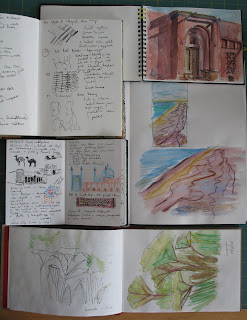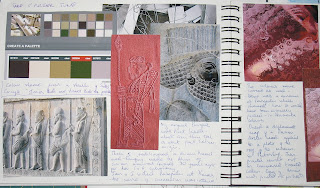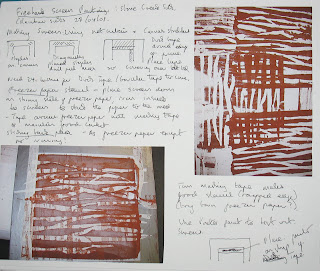For the past few weeks I've been working on some of the exercises as part of an online
'Studio Journals' course. Several people had questioned whether I needed this course having kept a variety of sketchbooks over the year. I've actually gained a great deal : an interactive forum for sharing experiences;practical tips; interesting new exercises and approaches (although some like using clipart didn't appeal as I prefer using my own images). It's also made me think about my whole preferred design process, how I use sketchbooks and areas where there is room for improvement!

One of the suggested principles of the course was that you keep one Studio Journal to gather everything together using the ' compost method' so that ideas from one project can cross to another projects. Rather tongue in cheek,( and not really in the spirit it was intended) I can also use this 'compost principle' to justify my use of multiple sketchbooks following the practice of composting in this household!
Ian is in charge of the 'Great Compost Experiment' which consists of :2 large 200L black compost bins( one full and left to rot down, one 'active' being added to); 1 dustbin of sieved compost; 2 small green containers for veggie peelings etc ( one indoors, 1 outdoors); 1 bag of paper shreddings; 2 sacks of clippings /green waste from garden.

So pushing this analagy, my equivalent of the containers for kitchen waste, garden clippings and paper shreddings (the 'gathering ' stage) are my current selection of sketchbooks pictured above. These are: 2 x A5 (1 portrait, 1 landscape format); 1x A6; 1 x A4 cartridge paper excercise book; 1 x A5 watercolour paper sketchbook. My most frequently used is the A6 which I keep as an illustrated diary when travelling, notes from exhibitions , lectures etc. The A5 sketchbooks tend to have a more traditional function eg I'll be taking these for drawing in situ on my painting holiday later this week. It's useful having 2 on the go so that when doing quick sketches,you don't have to wait for the page to dry before doing another. I've fairly recently discovered the very cheap but good quality A4 excercise books which I use as scribble pads taking notes on courses, sketching out ideas , ripping out pages for other purposes. Doesn't matter if it gets dribbled on when taking notes for dyeing for instance

Last year, I started keeping an A4 spiral sketchbook as a 'lab book', recording what I'd done for particular projects AFTER I'd completed them eg July Take it Further challenge on Persian Archers (above), notes on screenprinting course( below). It's a useful process to review what worked, what didn't and to distil and summarise. Although not an 'art journal' , I'm happy to show it to people and it acts as a compact portfolio of my current work. This, using the compost principle, is the equivalent of the dustbin of sieved compost.

I started a new A4 casebound sketchbook for the Studio Journal course. I have used it for the exercises and am beginning to realise that although I won't use it quite as intended, it could have a role to play for capturing ideas. Currently I have photos stored on the computer in an 'ideas' folder and inspirational articles and pictures from magazines stored in looseleaf binders . In one of the colour excercises we did, I combined photos with scanned copies from my A5 sketchbook and found matching swatchs of fabric (below)

Of course in the compost scheme of things, this is the black compost bin where the breakdown and transformation of materials takes place, the core of the process. As up until now this process has mainly taken place in my head , it will be interesting to see how useful I find committing ideas to a journal.
 I couldn't help a wry smile when I saw the theme for this months 'Take it Further Challenge' was 'BALANCE' as I had just been diagnosed with Labyrinthitis after a bout of intense vertigo and dizziness caused by a viral infection. Happily this has now cleared up but what else could be the subject of my August TIF but the 'labyrinths' of the inner ear.
I couldn't help a wry smile when I saw the theme for this months 'Take it Further Challenge' was 'BALANCE' as I had just been diagnosed with Labyrinthitis after a bout of intense vertigo and dizziness caused by a viral infection. Happily this has now cleared up but what else could be the subject of my August TIF but the 'labyrinths' of the inner ear. I searched for images on the web , thinking originally I would use the one above to tie in with the colour scheme but decided on the labelled b&w one below from the medical text book which looked like some exotic sea creature.
I searched for images on the web , thinking originally I would use the one above to tie in with the colour scheme but decided on the labelled b&w one below from the medical text book which looked like some exotic sea creature.  I printed out the image on cotton poplin and also on silk organza and then overlaid them , slightly offset, so the images didn't line up properly, giving a slightly blurred image.
I printed out the image on cotton poplin and also on silk organza and then overlaid them , slightly offset, so the images didn't line up properly, giving a slightly blurred image.  I wanted a rough quality to the stitching in keeping with my feelings of becoming unravelled. Outlining the shapes on the top layer only became quite disorientating as I found I was following the wrong line, becoming sidetracked. The large tacking stitches along the labelling lines were more successful, holding things together.
I wanted a rough quality to the stitching in keeping with my feelings of becoming unravelled. Outlining the shapes on the top layer only became quite disorientating as I found I was following the wrong line, becoming sidetracked. The large tacking stitches along the labelling lines were more successful, holding things together. Not a pretty or even very satisfying piece but thought provoking and very much about the process of matching stitch with intention. While I was sewing the long tacks, I was thinking how much I liked the mark they made and about doing more on future pieces. It's actually quite difficult to make such large stitches regular and I was questioning whether I actually wanted them to be regular and if not, how I could sustain that irregular look as I became more practiced in that stitch? I used to make quilts with very fine 12 stitches to the inch quilting then moved to using heavier threads for a bolder effect. How can I sew in a crude, random way when all my programming is to achieve a small, neat stitch?
Not a pretty or even very satisfying piece but thought provoking and very much about the process of matching stitch with intention. While I was sewing the long tacks, I was thinking how much I liked the mark they made and about doing more on future pieces. It's actually quite difficult to make such large stitches regular and I was questioning whether I actually wanted them to be regular and if not, how I could sustain that irregular look as I became more practiced in that stitch? I used to make quilts with very fine 12 stitches to the inch quilting then moved to using heavier threads for a bolder effect. How can I sew in a crude, random way when all my programming is to achieve a small, neat stitch?



































